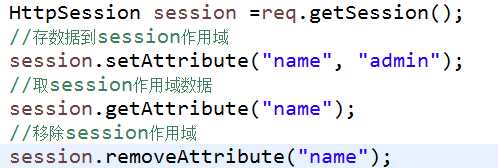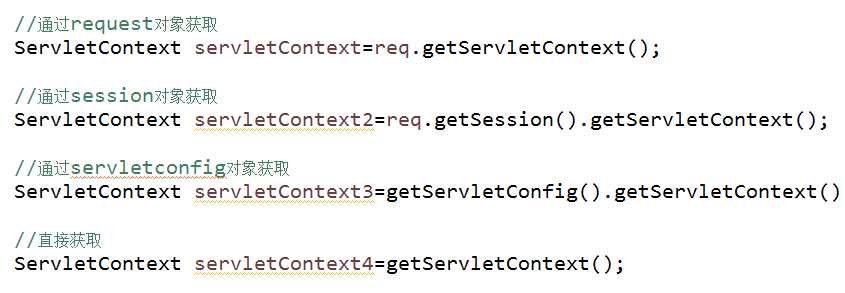标签:ade jar包 interval 输入 上传下载 表示 coding cti 存储
一、Session
1、介绍
HttpSession是一个纯粹的接口,session本身就属于HTTP协议的范畴。
session的作用就是为了标识一次会话,或者说确认一个用户;并且在一次会话(一个用户多次请求)期间共享数据。
2、创建对象和属性操作

3、表示会话JSESSIONID
每当一次请求到达服务器,如果访问了session,服务器会第一步查看是否从客户端回传一个名为JSESSION的Cookie,如果没有则认为这是一次新的会话,会创建一个新的session对象,并用唯一的JSESSIONID为此次会话做一个标志,如果有则认为这是之前标志过的一次会话,返回该对象,达到数据共享
4、session作用域
和request域一样可以通过setAttribute(name,value);方法向域对象中添加数据,通过getAttribute(name)从域对象中获取数据,通过removeAttribute(name)从域对象中移除数据。

5、session的销毁
因为session底层依赖Cookie实现,并且该Cookie的有效时间为关闭浏览器,所以关闭浏览器session失效
当非正常关闭服务器时,session销毁;当正常关闭服务器时,session将被序列化到磁盘上,下次启动服务自动加载到内存。
序列化:把对象和其状态存到本地磁盘
1)默认时间到期
Tomcat中session默认存活时间为30min,一旦有操作session会重新计时。
2)自己设定到期时间
·可以在Tomcat中的web.xml文件中进行修改
·session.setMaxInactiveInterval(int); 以秒为单位
3)立刻失效
session.invalidate();
session的销毁或失效意味着本次会话技术,数据共享结束。
二、ServletContext对象
1、介绍
每一个web应用有且仅有一个ServletContext对象,又称Application对象,该对象是与应用程序相关的,当WEB容器启动时,会为每一个WEB应用程序创建一个对应的ServletContext对象。
2、ServletContext对象的作用
1)作为域对象用来共享数据,此时数据在整个应用程序中共享
2)该对象中保存了当前应用程序的相关信息,可以通过方法获取。

3、ServletContext对象的四种获取方法

4、作为域对象
通过向ServletContext中存取数据,可以使得整个应用程序共享某些数据,不建议存放过多数据,因为ServletContext中的数据一旦存储进去没有手动移除会一直保存

三、文件上传下载
1、文件上传
前台页面:
请求方式为POST,form表单的enctype必须设为“multipart/form-data”.
后台:需要commos-io和commons-fileupload两个jar包(2.5版本的动态web项目)

protected void service(HttpServletRequest request, HttpServletResponse response) throws ServletException, IOException { // 设定编码,可以获取中文文件名 request.setCharacterEncoding("UTF-8"); // 获取tomcat下的upload目录的路径 String path = getServletContext().getRealPath("/upload"); // 临时文件目录 String tempPath = getServletContext().getRealPath("/temp"); // 检查我们是否有文件上传请求 // boolean isMultipart = ServletFileUpload.isMultipartContent( req); // 1、声明DiskFileItemFactory工厂类,用于在指定磁盘上设置一个临时目录 DiskFileItemFactory disk = new DiskFileItemFactory(1024 * 10, new File(tempPath)); // 2、声明ServletFileUpload,接收上面的临时文件。也可以默认值 ServletFileUpload up = new ServletFileUpload(disk); // 3、解析request try { List<FileItem> list = up.parseRequest(request); if (list.size() > 0) { for (FileItem file : list) // 判断是否是普通的表单项 if (file.isFormField()) { String fieldName = file.getFieldName(); // 中文乱码,此时还需要指定获取数据的编码方式 // String value = file.getString(); String value = file.getString("UTF-8"); System.out.println(fieldName + "=" + value); } else { // 说明是一个文件 // 获取文件本身的名称 String fileName = file.getName(); System.out.println(file.getFieldName()); // 处理文件名称 fileName = fileName.substring(fileName.lastIndexOf("\\") + 1); System.out.println("old Name : " + fileName); // 修改名称 String extName = fileName.substring(fileName.lastIndexOf(".")); String newName = UUID.randomUUID().toString().replace("-", "") + extName; // 保存新的名称,并写出到新文件中 file.write(new File(path + "/" + newName)); System.out.println("文件名是: " + fileName); System.out.println("文件大小是: " + file.getSize()); file.delete(); } } } catch (FileUploadException e) { e.printStackTrace(); } catch (Exception e) { e.printStackTrace(); } }
2、文件下载
前台:
设置download属性
后台实现下载:
public class DownloadServlet extends HttpServlet { @Override protected void service(HttpServletRequest req, HttpServletResponse resp) throws ServletException, IOException { // 设置请求 响应编码 req.setCharacterEncoding("UTF-8"); resp.setContentType("text/html;charset=UTF-8"); // 获取文件名 String fileName = req.getParameter("fileName"); // 判断文件名是否为空 if (fileName == null || fileName.length() < 1) { PrintWriter out = resp.getWriter(); out.write("<h1>请输入文件名</h1><a href=‘download.html‘>返回</a>"); out.close(); return; } // 获取存放文件的目录 String path = getServletContext().getRealPath("/upload/"); // 获取文件的路径 String filePath = path + fileName; // 通过路径获得file对象 File file = new File(filePath); // 判断file对象是不是存在而且是文件 if (file.exists() && file.isFile()) { // 下载 // 1、设置响应类型 resp.setContentType("application/x-msdownload"); // 2、设置下载的弹出框信息 resp.setHeader("Content-Disposition", "attachment;filename=" + fileName); // 3、获取字节输入流 InputStream is=new FileInputStream(filePath); // 3、获取字节输出流 ServletOutputStream out=resp.getOutputStream(); byte[] bs=new byte[1024]; int len=0; while ((len=is.read(bs))!=-1) { out.write(bs,0,len); } out.close(); is.close(); } else { PrintWriter out = resp.getWriter(); out.write("<h1>文件不存在</h1><a href=‘download.html‘>返回</a>"); out.close(); } } }
标签:ade jar包 interval 输入 上传下载 表示 coding cti 存储
原文地址:https://www.cnblogs.com/dhome/p/9557536.html